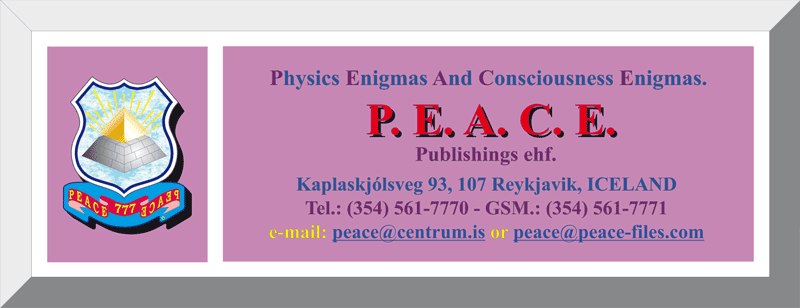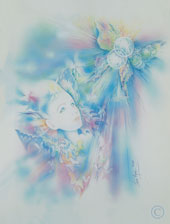 |
The Physics Enigmas And Consciousness Enigmas Files "The PEACE-Files" P. E. A. C. E.
|
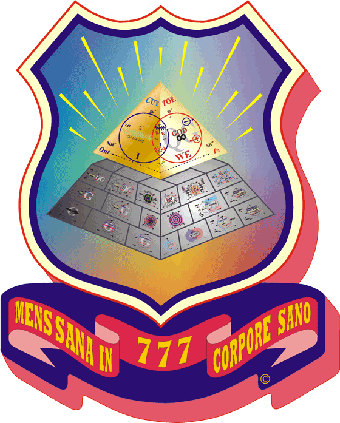
The 11th
QF- Letter-Essay.
The QF-theory and the
Double Slit Phenomena!
Theory of Everything
The
QF-Letters and their Subjects are:
| The QF : INTRODUCTIONS: | The
Initial
Findings of Man's
Greatest
Search: The QF-Ultimate Theory of Everything! |
| The First QF Letter: |
The Alternate Set-Mathematical Solution offered by: The QF-theory of Everything! |
| The Second QF Letter: |
The End of Theoretical Physics and the 6-dimensional QF-theoretical paradigm! |
|
The Third QF Letter: |
The QF-theory, the Parallel Universes Theories and The Limits of Mathematics! |
| The Fourth QF Letter: |
God
on the Brain and The
Riddle
of God and the Brain Neurological and Psychological Quagmire!
|
|
The Fifth QF Letter: |
From
the Riddle of
Désjà
vu, to the Riddle of the Autism Mystery!
|
|
The Sixth QF LETTER: |
The two Kinds of Hippocampal Volume Loss in Depressive and Alcoholic Individuals! |
|
The Seventh QF Letter: |
After the Genome! After the Double Helix! The Cancer and Consciousness connection! |
| The Eighth QF Letter: |
Life, Cancer and the Organization of Procaryot and Eucaryot DNA matching the Human Brain. |
| The Ninth QF Letter: |
The
QF-theory of the Brain's Empathy Center and its connections to Wars and
Crimes in Humanity. |
| The Tenth QF Letter: |
Sir Isaac Newton, the Rainbow and the QF-theory's Fundamental Color explaination. |
| The
Eleventh QF Letter: |
The QF-theory and the Riddles of the Double Slit Experiment! |
| The Twelfth QF Letter: |
The
Solution to One of Humanities oldest Riddle. The Interview with the Mysterious Mr. 666. |
"I think that a
particle must have
a separate
reality independent of the measure- ments. That is an electron has spin, location
and so forth even when it is not being measured. I like to think that the moon
is there even if I am not looking at it."
Quotation from: Professor Albert Einstein
The Twelfth
QF-Letter:
The Nineteenth
Century Mystery of
Light
and the
Thomas Young Double-Slit Wave
Mechanics Experiment.
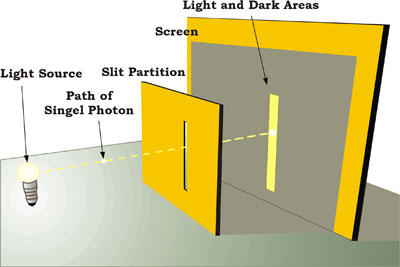 |
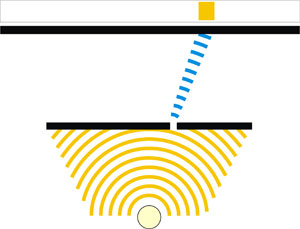 |
| This is what we see
on the screen with the light passing through one slit. |
This is the corresponding wave pattern with the light passing through one slit. |
Figure #01.
Anticipated passage of light on to a screen through
two slits.
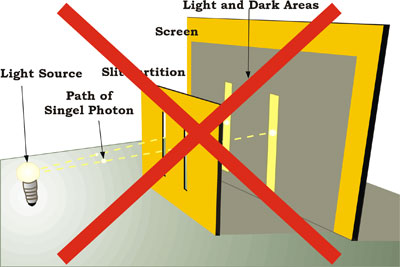 |
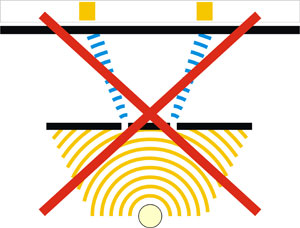 |
|
This is what we
expect to see on the screen with the light passing through two slits.
|
This is the wave
pattern we expect with light passing through two slits.
|
Figure #02.
Light actually passing on to a screen through two slits.
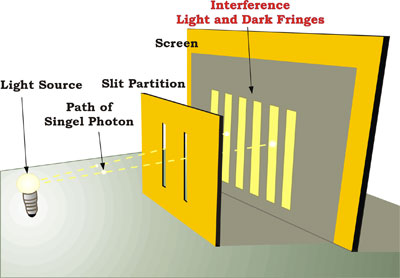 |
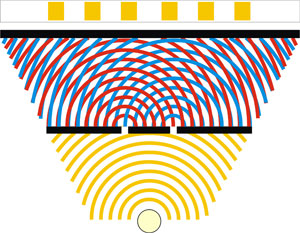 |
|
This is what we
actually see on the screen with the light passing through two slits.
|
This is the actual
wave pattern with light passing through two slits.
|
Figure #03.
Here is the double slit experiment light interference graphics in two forms, the firs is the drawing that Thomas Young made in order to explain the double slit phenomena, the next is a more recent graphical explanation for the IN and OUT of phase effects in the interaction of two waves.
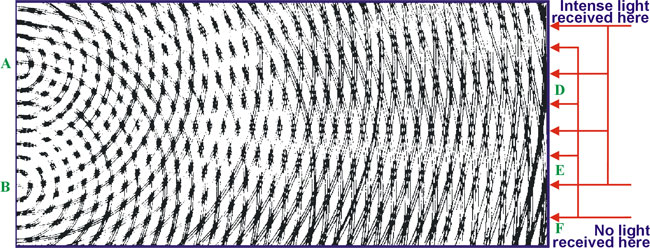 |
Figure #04.
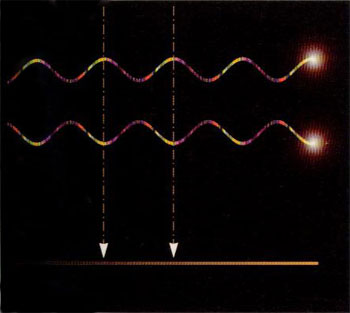 |
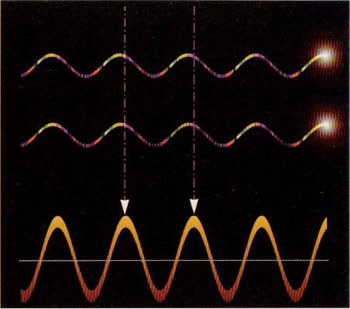 |
|
Here the wave crest
and through cancel each other out when the waves are out of phase.
|
Wave crests and
troughs coincide and reinforce each other when they are in phase.
|
Figure #05.
"I think I can safely say that nobody understands quantum mechanics... Do not keep saying to yourself, if you can possibly avoid it. 'But how can it be like that?' because you will go 'down the drain' into a blind alley from which nobody has yet escaped. Nobody knows how it can be like that"
Quotation from: Professor Richard Feynman
The Twentieth
Century Mystery of Light and the
Thomas Young Double Slit Particle-Wave
Mechanics
Experiments.
We shall now look at the mysteries that appears in the experimentation where just one particle is allowed to pass through the slits at at time, with considerable time-intervals before the nest one was allowed to pass. In these experimentation it does not matter whether we are using individual particles such as photons, electrons or even such massive particles as neutrons. However, for the sake of clarity, before we look at the behavior of "quantum reality" we begin by looking at reality as we know it in our everyday experience. This is the tainted golf balls experiment.
The Double Slit and the Individual Particle
Interaction.
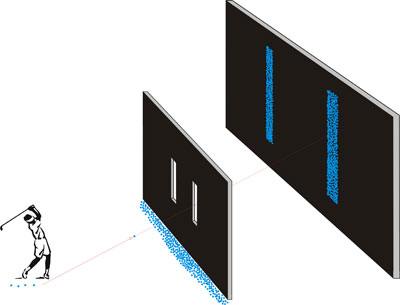 |
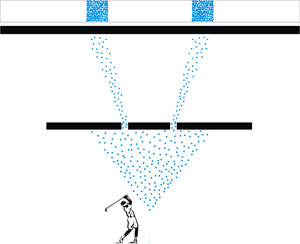 |
|
This golfer graphic
reminds us of the reality we are all experiencing, but golf ball
interference patterns are unthinkable.
|
The golfer tries to
hit the blue-color tainted golf balls through the slits, where those
who get through make two imprint lines.
|
Figure #06.
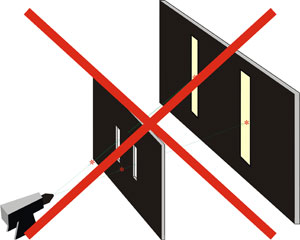 |
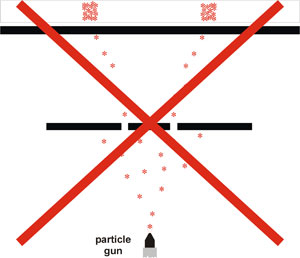 |
|
This is NOT what we
actually see on the screen, with the INDIVIDUAL particle fired
separately through the two slits.
|
This is NOT what happens with the
INDIVIDUAL particle being fired separately through the two slits.
|
Figure #07.
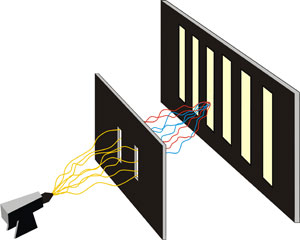 |
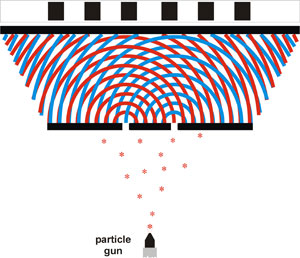 |
|
Even though just one particle is fired at a
time, we see
interference patt- erns on the screen. However, we do not see the paths of the
particles as in the drawing, but they represent the Feynman
explanation for the particle passage through the two slits.
|
This is the multiple Feynman
paths for just one particle from the particle gun to the screen. The
explanation requires the particle to pass through all possible paths
and thus on the way interfere with itself after passing through the
two slits.
|
Figure #08.
through either of the two slits on to a screen.
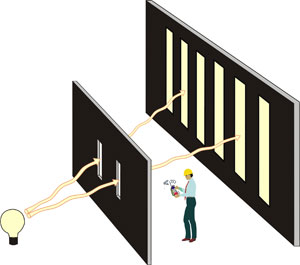 |
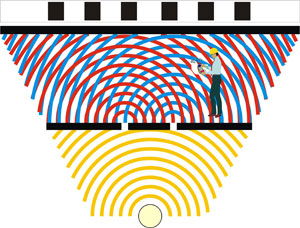 |
|
This is the seen
where we try to detect with a photoelectric
cell, the passage of the
particle through either of the two slits.
|
This is the actual
wave pattern with light passing through two slits just prior to the photoelectric cell
being switched on.
|
Figure #09.
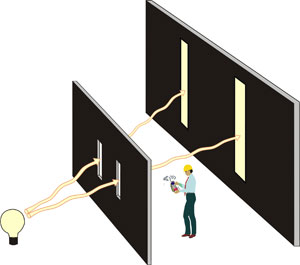 |
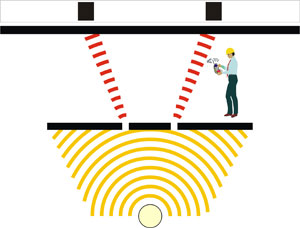 |
|
This is what we
actually see at the moment that the photoelectric
cell detector is
switched on at either of the two slits.
|
This is the actual
wave pattern with light, or individual particles, being detected with photoelectric
cells, passing the
slits.
|
Figure #10.
"Suppose we now see what happens when subatomic particles like neutrons are fired towards the two slits (instead of the golf balls). If we place a photographic film across the target then we find the striking result shown in Figure #08. The neutrons behave like the golf balls in the sense that each hit on the target film produces a definite mark. But as more and more neutrons are fired at the screen the individual hits build up a picture that has the characteristics of a wave interference pattern. There are bands where there is a high development of the target, evenly interspersed with underdeveloped bands each possessing some statistical scatter. Although the neutrons arrive at the target as distinct objects, like the golf balls, the probability that they hit a particular point on the target is determined by a wave intensity. If we close one of the slits then this produces a single wave-intensity distribution with no interference just as in the case with the light-waves. Hence the neutrons manifest particle and wave properties at the same time: they arrive at the target as distinct `hits', but with an intensity pattern characteristic of a wave.
There are further peculiar aspects of the wave interference pattern produced at the target screen by the neutrons, which make it subtler in nature than the 'ordinary' interference pattern produced by the light waves. If we fire the neutrons slowly, one at a time, towards the screen so that we can watch the film developing neutron by neutron, and so avoid any obvious interaction between different neutrons which would lead to interference, then we still find the interference pattern being built up bit by bit. More striking still, we could set up many identical versions of this experiment all over the world and fire just one neutron towards the slits in each of them at a prearranged moment. If we add together the results from all these completely different experiments we would find that the net result would look like the wave interference pattern! The single neutrons seem to be able to interfere with themselves. This is indeed 'one hand clapping'. We could have arranged for the different experiments to be huge distances apart and synchronized the performance of the different experiments so that in the time that it takes for the neutron to get from its source to the target no signal could travel, even at the speed of tight, between one experiment and another to cause a correlation of their results in some way. The result is the same the individual neutron-hits add to form a correlated interference pattern. How does each neutron know which role to play in order to produce the 'right' big picture of wave interference?
An even more perplexing fact about the microscopic two-slit experiment with the neutrons is that any attempt to unravel the wave-particle ambiguity and discover through which slit a particular neutron actually passed en route to the target invariably destroys the interference pattern seen at the target. Neutrons are rather delicate. If we set up a photoelectric cell at each slit in the screen to be triggered when a neutron passes through that slit, then we might expect to discover through which slit each individual neutron passes on its way to the target. Unfortunately this ambition can never be realized. The intervention of the light from the photoelectric cells alters the behavior of the neutrons in a manner that destroys the wavelike result of the experiment. If we are ever able to determine through which slit a neutron goes, then the pattern seen at the target screen is changed from the light-wave pattern of Figure #03 into the particle-like result of the golf balls in Figure #06. Whenever we decide to examine whether a neutron is behaving like a particle and determine through which slit it passes, then, and only then, it is found to behave as a particle. If we do not attempt to determine if it is behaving as a particle, then, and only then, it manifests itself as a wave. It is not possible to construct any device, which can determine through which slit a neutron has passed without destroying the wave interference pattern at the target.
This is quite unlike anything ever-encountered in classical physics. It confronts all philosophical positions regarding the character of-the laws of Nature and underlying reality with a totally novel challenge. It appears that the observer of the world plays a crucial role in determining what can be observed, but in a way that is subtly different from the old idealist view that everything is in the eye of the beholder. The naive realist would hold to the belief that there is an objective world that exists whether we like it or not, and which possesses definite properties that exist independent of any measurement of them. Unfortunately this does not stand up to its first encounter with the quantum laws of Nature. The observed phenomenon together with the act of observation together determine what can be observed in the two-slit experiment. This does not mean that one should conclude that everything observed is observer-created, in the sense that the idealist or the solipsist might claim. There is no reason to suspend belief in an underlying reality. It is just that the steps we take to establish it determine what it wilt be found to be. Reality is contextual. We must also recognize that, at the very least, this reality which dictates goings-on in the micro-world of photons and neutrons is very different from the approximate impression of it that we have assumed from our contact with large objects whose quantum wavelengths are minute, and whose wave-like properties are for all practical purposes indiscernible. It is not that golf balls do not possess wavelike attributes. They do. But golf balls are so large compared with neutrons and the length of their wave attributes so small, that wave interference effects are indiscernible by the human eye."
With all this in view it is not unexpected that this has lead to concepts of multitudes of universes, or what is known as the "Many Worlds Interpretation of Quantum Mechanics" or "Parallel Universes". However, this is not the way the QF-theory interprets the nature and fabric of reality. For that interpretation we shall have to take into account the QF-interpretation for the fabric of space and the QF-interpretation for the interaction of the particles of energy (Bosons) and matter (Fermions) with space. These comprise then the last part of this paper.
"No
point is more central than this, that empty space is not empty.
It is
the seat of the most violent physics."
Quotation from: Professor John Archibald Wheeler
The photon, which is the energy state of matter traveling at the speed of light, is the only fundamental particle that is both its matter and antimatter particle at the same time. With the photons being fired individually in the double slit experiment with some time intervals, it is the antimatter side of the photon that waves in the V-positive poles and the matter side that waves in the V-negative poles and thus a twofold wave is produced with a single photon. This is how the interference wave mechanics come about with a single photon being fired at intervals, but obviously the collapsing of the wave for each side will manifest opposite spins for each collapsed wave-package. Whether larger and many times more massive particles such as electrons and neutrons in this experiment are traveling at the speed of light and producing an antimatter wave is not clear.
The QF-theories description of individual photons, electrons or neutrons being fired on to a screen, through two slits.
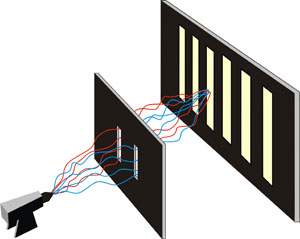 |
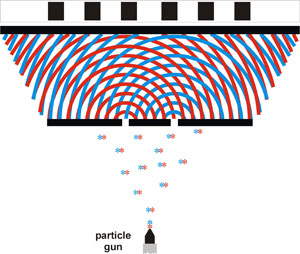 |
|
The
graphic shows a single photon- path
producing the interference patt- erns as it passes through the slits.
The
photon is also it s own antimatter particle.
|
This is the actual
wave pattern for the individual photon passing through two slits with
time intervals, where the single photon produces two wave-packages.
|
Figure #11.
The Virtual Matter/Energy V-poles, or the
QF-theory's
5th and 6th
Dimensions that form the Fabric of
Space.
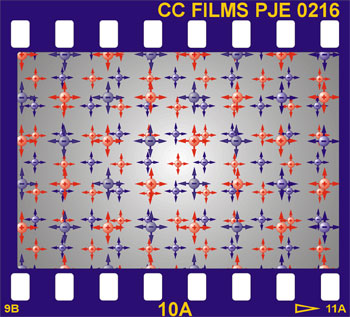 |
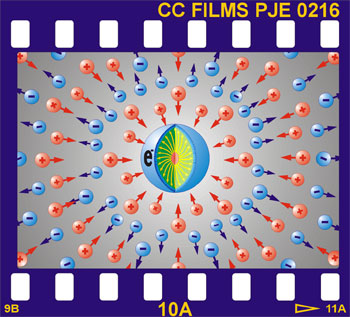 |
|
This is a
suggestive description for the Dual
V-poles nature of the Euclidean Space, with
proprieties where all imagi- nary lines intersect
each
other at right angles.
|
This is a suggestive description
for the Dual V-poles nature of the Rieman Space of General Relativity, with
proprieties where
all
imaginary lines intersect at different angles.
|
Figure #12.
"Quantum theory forces us to see the universe not as a collection of physical objects, but rather as a complicated web of relations between the various parts of a unified whole... All (physical) particles are dynamically composed of one another in a self-consistent way, and in that sense can be said to 'contain' one another. In (this theory), the emphasis is on the interaction, or 'interpenetration,' of all particles."
Quotation from: Professor Fritjof Capra
Written in English for the purpose of
publication
on the Internet.
for PEACE Publication
Ltd.
by Paul John II, 11th November 2004.
Recent subject references and articles:
http://www.pbs.org/wgbh/nova/elegant/program.html

